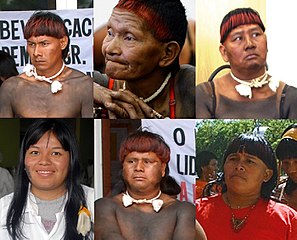 |
| Xavantes (cc Agência Brasil) |
A new paper proclaims that Xavantes appear to be one of the less mixed and or more genetically distinctive Native American people of present day.
Patricia C. Kuhn et al., Genome-Wide Analysis in Brazilian Xavante Indians Reveals Low Degree of Admixture. PLoS ONE 2012. Open access ··> LINK [doi: 10.1371/journal.pone.0042702]
Abstract
Characterization of population genetic variation and structure can be used as tools for research in human genetics and population isolates are of great interest. The aim of the present study was to characterize the genetic structure of Xavante Indians and compare it with other populations. The Xavante, an indigenous population living in Brazilian Central Plateau, is one of the largest native groups in Brazil. A subset of 53 unrelated subjects was selected from the initial sample of 300 Xavante Indians. Using 86,197 markers, Xavante were compared with all populations of HapMap Phase III and HGDP-CEPH projects and with a Southeast Brazilian population sample to establish its population structure. Principal Components Analysis showed that the Xavante Indians are concentrated in the Amerindian axis near other populations of known Amerindian ancestry such as Karitiana, Pima, Surui and Maya and a low degree of genetic admixture was observed. This is consistent with the historical records of bottlenecks experience and cultural isolation. By calculating pair-wise Fst statistics we characterized the genetic differentiation between Xavante Indians and representative populations of the HapMap and from HGDP-CEPH project. We found that the genetic differentiation between Xavante Indians and populations of Ameridian, Asian, European, and African ancestry increased progressively. Our results indicate that the Xavante is a population that remained genetically isolated over the past decades and can offer advantages for genome-wide mapping studies of inherited disorders.
The Xavantes, comprising today some 10,000 people, have suffered repeated hostility from the Western civilization in Brazil since centuries ago. In spite of all they have managed to remain proud and distinct.
| Fig. 2 three-dimensional global PCA with emphasis in American populations |
 |
| Fig. 3 (edited by me: only the labeling): neighbor-joining global tree |
Native Americans + Xavante are closer to W. Eurasians than to East Asians on this image? Is this really expected?
ReplyDeleteIt's an artifact induced by the presence of Mexicans (and some European admixture among Native Americans like "Colombians"). In fact they are not "closer" because the Mexican and Uyghur zone must be understood for what it is: mixed.
DeleteThat same admixture can well drive the Native Americans away from the East Asian branch. It is a good example of why autosomal genetics must be pondered from many angles before jumping to conclusions.